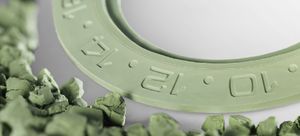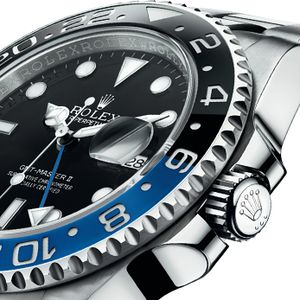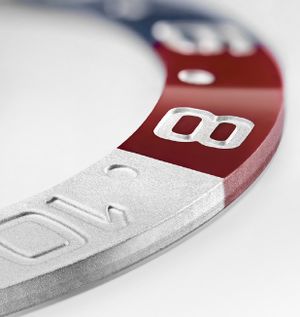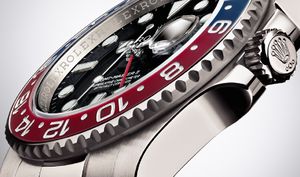Cerachrom bezel


Development of Rolex
(see also: Bezel)
Cherachrom
Derivation of a contraction of the French word "céramique" or English "ceramic" with the suffix "chrom", from the ancient Greek word for “colour”
Rolex developed and patented in 2005 the Cerachrom bezel for specific Professional models to ensure lasting beauty and functionality even after exposure to the most extreme conditions. Fashioned from extremely hard ceramic material, it is virtually impervious to scratches, and its colour is unaffected by ultraviolet rays. Its diamond‑polished surface presents an exceptional lustre. The engraved 24-hour graduations are coated with a thin layer of platinum.
The history of the Cerachrom bezel
Bezel of the model GMT Master-II 2013

EXCLUSIVE TWO-COLOUR CERACHROM BEZEL
A technological and aesthetic feat, the new CERACHROM bezel insert is obtained by a unique process developed and patented by Rolex which allows this ceramic component with two distinct colours to be produced as a single piece. It echoes the traditional two-colour bezel of the original GMT-MASTER and GMT-MASTER II models. The CERACHROM insert, introduced in 2005, has the advantage of being virtually scratchproof, highly corrosion resistant, and its colour is unaffected by ultraviolet rays. Its diamond-polished surface presents an exceptional lustre. The engraved 24-hour graduations are coated with a thin layer of platinum via a PVD (Physical Vapour Deposition) process.
Bezel of the model GMT Master-II 2014


IN THE BEGINNING,THERE WAS RED AND BLUE
From its launch in 1955, the Rolex GMT-Master stood out with its rotatable 24-hour graduated red and blue bezel. Thanks to an additional hand that circled the dial once every 24 hours, airline pilots on intercontinental flights – a rapidly expanding sector at the time – could read the time in two time zones simultaneously. Red and blue, situated at opposite ends of the colour spectrum, are strongly contrasting colours for the human eye, a determining factor for legibility on a Professional watch. The first GMT-Master bezel inserts were made of transparent Plexiglas, painted half red and half blue on the underside. This method of production gave a certain depth to the bezel, as the colour showed through the Plexiglas.
In 1955, still in the original two colours, the Plexiglas insert was replaced by one in anodized aluminium once the manufacture of a two-colour insert in this material had been mastered. Various other combinations were introduced later, such as brown and gold on Rolesor (steel and gold) models, or burgundy and black on the GMT-Master II launched in 1982. But in the minds of many GMT-Master lovers, a red and blue bezel remains the signature feature of this model.
THE CERACHROM BEZEL,AN IDEAL CERAMIC COMPONENT
In 2005, after several years’ research, Rolex developed in-house and patented a new high-performance component to equip the rotatable bezels of its watches: the Cerachrom insert. The polished surface of this extremely resistant ceramic insert features a deep, long-lasting lustre and provides a sharp contrast to the precisely engraved numerals and graduations coated in a thin layer of gold or platinum. Ceramic is a material with exceptional robustness and durability: it is virtually scratchproof, resistant to corrosion, and its colour is unaffected by ultraviolet rays. For Rolex, a brand that constantly seeks to innovate and perfect, this material constitutes the ideal replacement for the previously used anodized aluminium. The Oyster Perpetual GMT-Master II was the first model in the Oyster collection to benefit from the Cerachrom bezel technology, and the new Cerachrom insert was adopted in 2005 in a uniform black colour.
ROLEX KNOW-HOW
In keeping with its quality standards and its mastery of the production of all its key watch components, Rolex developed in-house the expertise, processes and high-technology equipment needed to acquire complete independence in the production of its ceramic components. The workshops are housed at the impressive Rolex Plan-les-Ouates production site on the outskirts of Geneva. There, the brand makes all the elements for its cases and bracelets, starting with the casting of its own gold alloys or the sourcing of other raw materials, to their machining, assembly and polishing. The production of ceramic components is completely mastered, from raw material to the finished Cerachrom bezel insert. Such complete in-house mastery allows Rolex to devise innovative solutions and create components that correspond exactly to its specifications and quality criteria.
Since 2007, Rolex expertise has produced exclusive Cerachrom bezel inserts in blue and in green – in addition to black – for its Oyster Perpetual Submariner Date models or its 18 ct yellow gold Oyster Perpetual Yacht-Master II. In 2010, it took another leap forward in developing a monobloc Cerachrom bezel – rather than a bezel insert – to equip the Cosmograph Daytona. It first appeared in black, and then in brown in 2013 on the platinum version that marked the 50th anniversary of the legendary chronograph.
During all this time, the creation of a two-colour ceramic bezel – which should, moreover, be half red – remained mission impossible from a technical point of view. Yet the extensive internal resources of the Research and Development Department took up the challenge and finally managed to combine the technical performance of the Cerachrom bezel with the iconic two-colour aesthetics of the GMT-Master.
In 2013, after many years of research and fine-tuning the exclusive manufacturing process, Rolex unveiled the first two-colour Cerachrom insert in the world – in blue and black. Now, in 2014, that mission has been brought to a successful conclusion with the introduction of a two-colour Cerachrom insert in red and blue that complies with Rolex’s strict quality standards for its watch components.
RED AND BLUE CERACHROM
The name “Cerachrom” derives from a contraction of the word “ceramic” juxtaposed with the suffix “chrom” from the ancient Greek word for “colour”. The range of available shades for ceramic is however restricted by its very manufacturing process. Colours are generally created by adding mineral pigments that can withstand the very high temperatures at which the ceramic is fired for its densification and to acquire its characteristic hardness. Red, typically, is a colour for which no stable mineral pigments exist to create a Cerachrom component. Rolex nevertheless managed, in the first instance, to produce a red ceramic according to a secret process. But, for the brand, this innovation represented only half the journey – or, more precisely, took the brand only half way to manufacturing the emblematic red and blue Cerachrom insert.
Rolex’s in-house engineers finally found an answer to the second half of the challenge. The ingenious process consists of introducing an intermediate step in the manufacture of the standard Cerachrom insert. During this innovative bulkcolouring step, half of the red ceramic insert is coloured blue. The colour is achieved by impregnating the part of the insert representing night-time hours, between 6 p.m. and 6 a.m., with a controlled quantity of a solution of chemical compounds. The solution is added before sintering at more than 1,600 °C, when the ceramic acquires its mechanical resistance properties as well as its colour. In the course of this firing, the ceramic densifies and the added compounds react with the basic elements of the red Cerachrom insert to conjure up the final blue colour.
Although the idea in itself may appear simple, a number of major technical hurdles had to be overcome before it could be implemented: the formulation of a solution of precursor chemical compounds that would turn red into blue; the homogenous application of an appropriate quantity of this solution; ensuring a sharp, precise and clear demarcation between the two coloured areas, the definition of the precise length of time and temperature for the sintering so as to prevent any distortion of the piece. Every single one of these parameters is crucial for the success of the process and the quality of the final product.
Bezel of the model Yacht-Master 2015

BLACK MATTE AND SHINY CERACHROM BEZEL
The new Cerachrom insert in black ceramic fitted in the rotatable bezel is true to the Yacht-Master’s identity. The raised numerals and graduations with a highly polished finish stand out clearly against a matt background, allowing the wearer to easily read elapsed times of up to 60 minutes. [1]